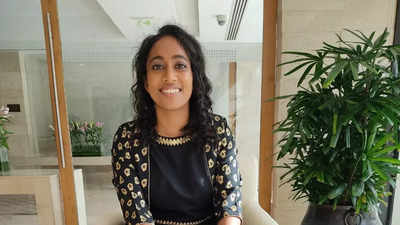- News
- India News
- From Andhra town to space with Branson: Sirisha Bandla on her flight to stardom
Trending
This story is from June 27, 2022
From Andhra town to space with Branson: Sirisha Bandla on her flight to stardom
From a young child in an Andhra town who loved watching the stars to becoming the third Indian-origin woman (after Kalpana Chawla and Sunita Williams) to enter space last year, aeronautical engineer and commercial astronaut Sirisha Bandla has come a long way. During a recent visit to her country of birth, the vice-president of Virgin Galactic talks to TOI about her space journey

From a young child in an Andhra town who loved watching the stars to becoming the third Indian-origin woman (after Kalpana Chawla and Sunita Williams ) to enter space last year, aeronautical engineer and commercial astronaut Sirisha Bandla has come a long way. During a recent visit to her country of birth, the vice-president of Virgin Galactic talks to TOI about her space journey. Excerpts from her interview:
Q. Will you share your experience of space travel last year with company founder Richard Branson?
It was incredible. The flight (Virgin Galactic Unity 22 launched on July 11, 2021) went off very well. I wasn’t nervous, and everything on my test cards and mission objectives with my crewmates was completed. Though the suborbital testflight duration was 90 minutes, we experienced weightlessness for around 3-4 minutes in space. We turned to each other and gave high-fives.Richard was far from me, so we touched feet for a high-five. Given an opportunity, I would love to go to space again.
Q. Tell us about your work at Virgin Galactic?
As VP research, my interaction is usually with the scientific community. So, you can fly a research experiment to space or you can fly with it and conduct the experiment yourself. Currently, if a researcher has to do an experiment in space, he or she has to approach a government agency like Nasa, Isro, or JAXA. The agency will send the payload to space, get the data and then share the same with the researcher. This process is time-consuming. But now, spaceflights are providing researchers an opportunity to go to space and do the experiments themselves.

Q. And your India connection?
I was born in Andhra Pradesh’s Chirala city (in Bapatla district). When I was around five, my parents moved to the US. I knew Telugu then and learned English in the US. Unfortunately, my Telugu is degrading now. My grandparents later moved from Chirala to Guntur. While growing up, we used to spend summers in Andhra. My sister and I have a lot of fond memories, especially of the food.
Q. What inspired you to become an aeronautical engineer?
I don’t remember what exactly inspired me. But what I do remember is that when I was young in India, I liked looking at the stars when the power was out. I used to drag my parents to every air show and space museum and they never said no. They helped me get a pilot’s licence and encouraged me at every step.
Q. You have become a role model for women who aspire to join the space sector. Any thoughts you want to share with them?
I got tons of messages after the space journey. A lot of them came from young women in India about what my dream and space trip meant to them. I just want to tell the young women who aspire to join this field to do what excites you. That’s what is going to take you to new heights. It won’t be a straight line where you want to go. But if you keep reminding yourself about your goal, you will certainly find a path there. You can work with government (agencies) or with the private sector, you can work with satellites or with customers for space flight. There are so many options now.

Q. How do you see the race for space and moon among government agencies and private players panning out?
One of the great things about the commercial space industry is that it provides services to government agencies, thus freeing up resources and funds for agencies to focus on more ambitious goals like going to the moon, Mars or asteroids. Nasa has been our customer and every spaceflight we launched, they had at least one research payload on it.

Q. Your views on India’s space programme?
It’s not an easy feat to put any vehicle on a surface. It takes great leadership and incredibly skilled engineers. Isro is at the forefront of science and technology. I am looking forward to seeing their human spaceflight programme (Gaganyaan) progress. I liked their bottoms-up approach.
Q. Space travel is an expensive affair. Is it likely to become cheaper in the future?
One thing about suborbital flight is that it can be a cost-effective option for science, research and technology development. On the space tourism side, we are building a large fleet of space flights. We plan to have multiple spaceships and motherships so as to build a fleet of 400 space flights a year. As we reach that scale, we hope to see the travel cost come down.
End of Article
FOLLOW US ON SOCIAL MEDIA










